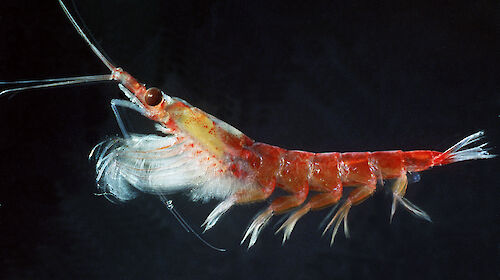The Australian icebreaker, RSV Aurora Australis returns to Hobart today (Friday 9 March 2001) following a 10 week Antarctic research voyage. Researchers aboard the ship carried out a number of research programs – principal among them investigations into the interaction between krill and their many predators, as well as a major research program focusing on the history of retreat and advance of the massive Amery ice-shelf, near Australia’s Davis station.
The investigations into krill populations and distribution, conducted from onboard the Aurora Australis, were carried out in conjunction with research undertaken on Béchervaise Island near Australia’s Mawson station – the site of a 10 year study of a small Adélie penguin colony. Satellite-tracking transmitters, fitted to the Adélies, allowed researchers on the ship to find precisely the penguins’ feeding location. This provided researchers with a unique opportunity to assess the relationship between krill abundance and penguin population survival. Conducted at a time when parent birds were foraging for food for their new chicks – it was the first time researchers have attempted to link directly predator foraging with food and prey in their particular region.
The surveys, carried out by the shipboard researchers were within a 60 by 60 nautical mile sector of the icy Antarctic waters – the surveys also revealed the attraction of the krill swarms to other predators, particularly a number of whale species.
Oceanographer with the Antarctic CRC and leader of the ship-based component of the (Amery Ice Shelf-Ocean Research) AMISOR project, Dr Nathan Bindoff, said today that the research programs on the ice shelf itself, together with the complementary oceanographic studies conducted from onboard the Aurora Australis, had been very successful. “We have managed to achieve all of our objectives in this complex and multi-faceted research program. A separate team of glaciologists camped out on the ice shelf were successful in their program to drill through the north-eastern corner of the ice shelf with a hot water drill. Getting through the 400 metres of ice allowed access to sediment samples from the sea floor below the ice-shelf and it also enabled them to successfully place instruments into the bore holes to measure waters beneath the ice”, Dr Bindoff said.
Aboard the Aurora Australis oceanographers used ocean measurements of temperature, salinity, and velocity to estimate the melt and re-freeze rate of the ice-shelf and recorded the concentration of oxygen and nutrients in the water column.
“The combined studies have provided comprehensive data that will contribute to the monitoring of changes in ice-shelves over time as a response to climate change. We are also collecting valuable data from sea-floor moorings that we deployed during the voyage. The moorings are equipped with a range of instruments, including upward looking sonars (ULS) that are measuring the thickness of the ice that is now starting to re-form as winter approaches”, Dr Bindoff said today.
The Aurora Australis is scheduled to arrive at Macquarie Wharf No 3 at 2:30 PM on Friday 9 March 2001. The ship will then be readied for the final voyage of the Australian Antarctic season departing Monday 12 March.

